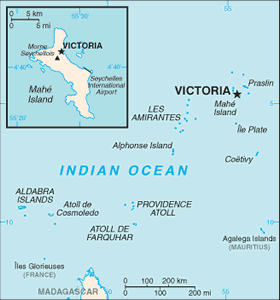The Geography of Seychelles
The Geography of Seychelles
Seychellois Geography
Location: archipelago in the Indian Ocean, northeast of Madagascar
Geographic coordinates: 4 35 S, 55 40 E
Map references: Africa
Area: total: 455 sq km land: 455 sq km water: 0 sq km
Area - comparative: 2.5 times the size of Washington, DC
Land boundaries: 0 km
Coastline: 491 km
Maritime claims: territorial sea: 12 nm contiguous zone: 24 nm exclusive economic zone: 200 nm continental shelf: 200 nm or to the edge of the continental margin
Climate: tropical marine; humid; cooler season during southeast monsoon (late May to September); warmer season during northwest monsoon (March to May)
Terrain: Mahe Group is granitic, narrow coastal strip, rocky, hilly; others are coral, flat, elevated reefs
Elevation extremes: lowest point: Indian Ocean 0 m highest point: Morne Seychellois 905 m
Natural resources: fish, copra, cinnamon trees
Land use: arable land: 2.17% permanent crops: 13.04% other: 84.79% (2005)
Irrigated land: NA
Natural hazards: lies outside the cyclone belt, so severe storms are rare; short droughts possible
Environment - current issues: water supply depends on catchments to collect rainwater
Environment - international agreements: party to: Biodiversity, Climate Change, Climate Change-Kyoto Protocol, Desertification, Endangered Species, Hazardous Wastes, Law of the Sea, Marine Dumping, Ozone Layer Protection, Ship Pollution, Wetlands signed, but not ratified: none of the selected agreements
Geography - note: 41 granitic and about 75 coralline islands


